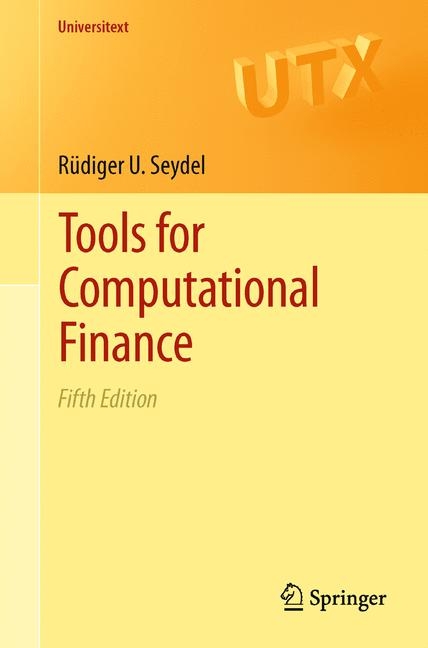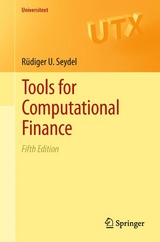Tools for Computational Finance
Seiten
2012
|
5th ed. 2012
Springer London Ltd (Verlag)
978-1-4471-2992-9 (ISBN)
Springer London Ltd (Verlag)
978-1-4471-2992-9 (ISBN)
- Titel erscheint in neuer Auflage
- Artikel merken
Zu diesem Artikel existiert eine Nachauflage
Using a `learning by calculating’ approach, this comprehensive introductory text shows how stochastic computational methods are used across the field of finance. The revised and expanded fifth edition includes updates, as well as new material and exercises.
The disciplines of financial engineering and numerical computation differ greatly, however computational methods are used in a number of ways across the field of finance. It is the aim of this book to explain how such methods work in financial engineering; specifically the use of numerical methods as tools for computational finance. By concentrating on the field of option pricing, a core task of financial engineering and risk analysis, this book explores a wide range of computational tools in a coherent and focused manner and will be of use to the entire field of computational finance. Starting with an introductory chapter that presents the financial and stochastic background, the remainder of the book goes on to detail computational methods using both stochastic and deterministic approaches.
Now in its fifth edition, Tools for Computational Finance has been significantly revised and contains:
A new chapter on incomplete markets which links to new appendices on Viscosity solutions and the Dupire equation;
Several new parts throughout the book such as that on the calculation of sensitivities (Sect. 3.7) and the introduction of penalty methods and their application to a two-factor model (Sect. 6.7)
Additional material in the field of analytical methods including Kim’s integral representation and its computation
Guidelines for comparing algorithms and judging their efficiency
An extended chapter on finite elements that now includes a discussion of two-asset options
Additional exercises, figures and references
Written from the perspective of an applied mathematician, methods are introduced as tools within the book for immediate and straightforward application. A `learning by calculating’ approach is adopted throughout this book enabling readers to explore several areas of the financial world.
Interdisciplinary in nature, this book will appeal to advanced undergraduate students in mathematics, engineering and other scientific disciplines as well as professionals in financial engineering.
The disciplines of financial engineering and numerical computation differ greatly, however computational methods are used in a number of ways across the field of finance. It is the aim of this book to explain how such methods work in financial engineering; specifically the use of numerical methods as tools for computational finance. By concentrating on the field of option pricing, a core task of financial engineering and risk analysis, this book explores a wide range of computational tools in a coherent and focused manner and will be of use to the entire field of computational finance. Starting with an introductory chapter that presents the financial and stochastic background, the remainder of the book goes on to detail computational methods using both stochastic and deterministic approaches.
Now in its fifth edition, Tools for Computational Finance has been significantly revised and contains:
A new chapter on incomplete markets which links to new appendices on Viscosity solutions and the Dupire equation;
Several new parts throughout the book such as that on the calculation of sensitivities (Sect. 3.7) and the introduction of penalty methods and their application to a two-factor model (Sect. 6.7)
Additional material in the field of analytical methods including Kim’s integral representation and its computation
Guidelines for comparing algorithms and judging their efficiency
An extended chapter on finite elements that now includes a discussion of two-asset options
Additional exercises, figures and references
Written from the perspective of an applied mathematician, methods are introduced as tools within the book for immediate and straightforward application. A `learning by calculating’ approach is adopted throughout this book enabling readers to explore several areas of the financial world.
Interdisciplinary in nature, this book will appeal to advanced undergraduate students in mathematics, engineering and other scientific disciplines as well as professionals in financial engineering.
Modeling Tools for Financial Options.- Generating Random Numbers with Specified Distributions.- Monte Carlo Simulation with Stochastic Differential Equations.- Standard Methods for Standard Options.- Finite-Element Methods.- Pricing of Exotic Options.- Beyond Black and Scholes.
| Reihe/Serie | Universitext |
|---|---|
| Zusatzinfo | 7 Tables, black and white; 98 Illustrations, black and white; XVII, 429 p. 98 illus. |
| Verlagsort | England |
| Sprache | englisch |
| Maße | 155 x 235 mm |
| Gewicht | 682 g |
| Themenwelt | Mathematik / Informatik ► Mathematik ► Analysis |
| Wirtschaft ► Allgemeines / Lexika | |
| Wirtschaft ► Betriebswirtschaft / Management | |
| Schlagworte | Computational Finance • Finanzmathematik • finite differences and elements • Monte Carlo • Monte-Carlo-Methode • numerical methods in financial engineering • Option pricing • Optionspreisberechnung • Stochastik |
| ISBN-10 | 1-4471-2992-X / 144712992X |
| ISBN-13 | 978-1-4471-2992-9 / 9781447129929 |
| Zustand | Neuware |
| Haben Sie eine Frage zum Produkt? |
Mehr entdecken
aus dem Bereich
aus dem Bereich
Band 5: Hydraulik, Stromfadentheorie, Wellentheorie, Gasdynamik
Buch | Softcover (2024)
De Gruyter Oldenbourg (Verlag)
59,95 €





